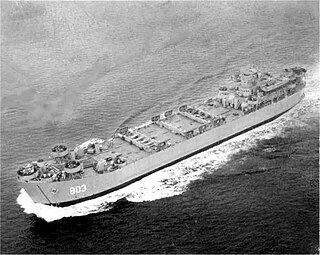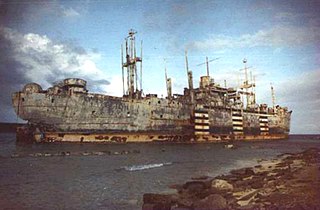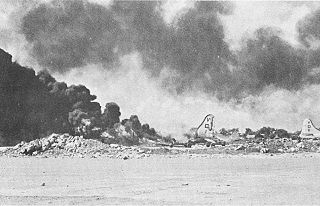Related Research Articles

Saipan is the largest island and capital of the Northern Mariana Islands, a commonwealth of the United States in the western Pacific Ocean. According to 2020 estimates by the United States Census Bureau, the population of Saipan was 43,385, a decline of 10% from its 2010 count of 48,220.

USS Whale (SS-239), a Gato-class submarine, was the second ship of the United States Navy to be named for a whale, an extremely large, aquatic mammal that is fishlike in form. The USS Cachalot (SS-170) commissioned on 1 December 1933 preceded the Whale.
USS Moray (SS-300), a Balao-class submarine, was a ship of the United States Navy named for the moray, a family of large eels found in crevices of coral reefs in tropical and subtropical oceans.

The Battle of Tinian was part of the Pacific campaign of World War II, fought on the island of Tinian in the Mariana Islands from 24 July until 1 August 1944. The 8,000-man Japanese garrison was eliminated, and the island joined Saipan and Guam as a base for the Twentieth Air Force.

USS Pilotfish (SS-386), a Balao-class submarine, was a ship of the United States Navy named after the pilot fish, a carangoid fish, often seen in warm latitudes in company with sharks.

USS Pintado (SS-387/AGSS-387), a Balao-class submarine, was the first ship of the United States Navy to be named for the pintado.

USS Twining (DD-540), a Fletcher-class destroyer, was a ship of the United States Navy named for Rear Admiral Nathan C. Twining (1869–1924).

USS Monssen (DD-798) was a Fletcher-class destroyer of the United States Navy, the second Navy ship named for Lieutenant Mons Monssen (1867–1930), who was awarded the Medal of Honor for putting out a fire in a magazine on Missouri.

Saipan International Airport, also known as Francisco C. Ada/Saipan International Airport, is a public airport located on Saipan Island in the United States Commonwealth of the Northern Mariana Islands. The airport is owned by Commonwealth Ports Authority. Its airfield was previously known as Aslito and Isely Field.

Sakae Ōba was an officer of the Imperial Japanese Army during World War II. He served in both China and in the Pacific campaign. After Japanese forces were defeated in the Battle of Saipan, he led a group of soldiers and civilians deep into the jungle to evade capture by Allied forces. Under Ōba's leadership, the group survived for over a year after the battle and finally surrendered in December 1945, three months after the war had ended. Following his return to Japan, he became a successful businessman and served on the city council of Gamagōri.

USS Orange County (LST–1068) was an LST-542-class tank landing ship built for the United States Navy during World War II. Unlike many of her class, which received only numbers and were disposed of after World War II, she survived long enough to be named. On 1 July 1955, all LSTs still in commission were named for US counties or parishes; LST-1068 was given the name Orange County, for counties in the states of California, Florida, Indiana, New York, North Carolina, Texas, Vermont, and Virginia, she was the only US Naval vessel to bear the name.

The USS Hampden County (LST-803) was an LST-542-class tank landing ship built for the United States Navy during World War II. Named after Hampden County, Massachusetts, she was the only U.S. Naval vessel to bear the name.
USS LST-850 was an LST-542-class tank landing ship built for the United States Navy during World War II. Late in her career, she was renamed Juniata County (LST-850)—after Juniata County, Pennsylvania, the only U.S. Naval vessel to bear the name—but never saw active service under that name.

USS Cabell (AK-166) was an Alamosa-class cargo ship commissioned by the US Navy for service in World War II. She was responsible for delivering troops, goods and equipment to locations in the war zone.

USS Brookings (APA-140) was a Haskell-class attack transport in service with the United States Navy from 1945 to 1946. She was scuttled in 1992.

The 318th Fighter Group was a World War II United States Army Air Forces combat organization. It served primarily in the Pacific Ocean theater of World War II.

The XXI Bomber Command was a unit of the Twentieth Air Force in the Mariana Islands for strategic bombing during World War II.

The Bombing of Hamamatsu in World War II was part of the strategic bombing campaign waged by the United States of America against military and civilian targets and population centers of the Empire of Japan during the Japan home islands campaign in the closing states of World War II.

During World War II, a series of Japanese air attacks on the Mariana Islands took place between November 1944 and January 1945. These raids targeted United States Army Air Forces (USAAF) bases and sought to disrupt the bombing of Japan by Boeing B-29 Superfortress heavy bombers operating from the islands. The Japanese lost 37 aircraft during this operation, but destroyed 11 B-29s and damaged a further 43. Preparations were also made for commando raids on the bases in early and mid-1945 but these did not go ahead.
A small independent cinema of Northern Mariana Islands scene, producing mostly documentary films, developed in the 21st century thanks to the efforts of the Commonwealth of the Northern Mariana Islands and of the Northern Marianas College. Films had already been shot in the islands in the 20th century by foreign producers.
References
- 1 2 "Target T" (downloads & transcript available]). Victory in the Pacific. PBS . Retrieved 9 October 2008.
{{cite web}}: External link in|format= - 1 2 "Target Tokyo (1945)". IMDb. Retrieved 17 January 2020.